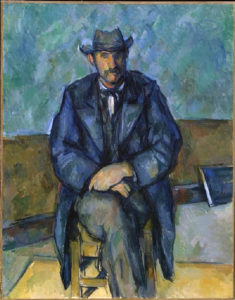R943 – Portrait de paysan, 1904-1906 (FWN542)
Pavel Machotka
(Cliquer sur l’image pour l’agrandir)
Of the late portraits, Portrait de paysan is the most incisive; it helps not to know his identity and to be able to concentrate undisturbed on the extraordinary painting. The coat is painted with multiple outlines, emphatic, heavy, and even craggy, as if it always protected him from the elements or from an unfriendly world; the hands are so flat as to seem cut away from the figure. The painting is powerful, at every point consistent in its purpose; it fits its model, who himself is a strong figure used to hard work, with large hands and strong legs. Where the drawing is forceful, however, the colors are understated. Browns are set against a curious mixture of blues and greens, and against an unassuming harmony of unsaturated, secondary colors that Cézanne weaves relentlessly into all the areas of the painting. The seemingly black coat and the dark trousers are in fact, light brown, green, and blue, as well as blue-black; and the green wall is in turn suffused with blues. The color scheme provides a carefully calculated setting for the face, whose browns, yellows, and reds concentrate our gaze and complete the color scheme in the same way a capstone completes an arch; the sharp outlines, the pointed chin, and the self-contained pose convey the sitter’s character fully, it seems, even without the second eye.
Source: Machotka, Cézanne: the Eye and the Mind.


